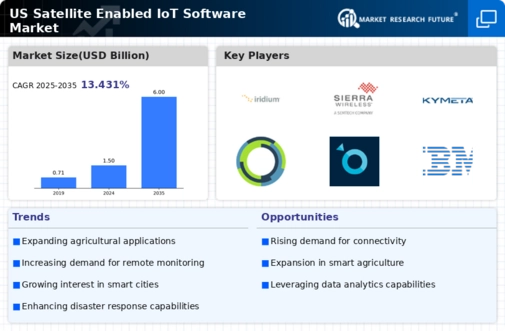Rising Demand for Remote Monitoring
The satellite enabled-iot-software market is experiencing a notable surge in demand for remote monitoring solutions across various sectors. Industries such as agriculture, oil and gas, and logistics are increasingly relying on satellite technology to monitor assets in real-time, especially in remote locations. This trend is driven by the need for enhanced operational efficiency and reduced downtime. According to recent estimates, the market for remote monitoring solutions is projected to grow at a CAGR of approximately 15% over the next five years. As organizations seek to optimize their operations, the satellite enabled-iot-software market is positioned to benefit significantly from this rising demand.
Advancements in Satellite Technology
Technological advancements in satellite systems are significantly impacting the satellite enabled-iot-software market. Innovations such as low Earth orbit (LEO) satellites are enhancing data transmission speeds and reducing latency, making satellite IoT solutions more viable for various applications. These advancements are likely to attract new players into the market, fostering competition and driving down costs. As a result, the adoption of satellite enabled-iot-software is expected to increase, particularly in sectors that require real-time data access. The market is projected to grow by approximately 20% over the next few years, driven by these technological improvements.
Integration with Smart City Initiatives
The satellite enabled-iot-software market is poised to gain traction from the integration of IoT solutions into smart city initiatives. As urban areas in the US continue to expand, municipalities are increasingly adopting satellite technology to enhance infrastructure management, traffic monitoring, and public safety. This integration allows for improved data collection and analysis, facilitating better decision-making processes. The smart city market is expected to reach a valuation of $1 trillion by 2025, indicating a substantial opportunity for satellite enabled-iot-software providers to contribute to urban development and sustainability efforts.
Growing Focus on Supply Chain Optimization
The satellite enabled-iot-software market is witnessing a growing focus on supply chain optimization, particularly in industries such as logistics and transportation. Companies are increasingly utilizing satellite technology to track shipments and monitor inventory levels in real-time, which enhances transparency and efficiency. This trend is driven by the need to reduce operational costs and improve customer satisfaction. The logistics sector is projected to invest over $100 billion in IoT solutions by 2026, indicating a substantial opportunity for satellite enabled-iot-software providers to capitalize on this demand.
Regulatory Support for Satellite Communications
The satellite enabled-iot-software market is benefiting from increasing regulatory support for satellite communications in the US. Government initiatives aimed at expanding broadband access and enhancing communication infrastructure are creating a favorable environment for satellite technology adoption. Policies that promote the use of satellite systems for rural connectivity and emergency response are likely to drive growth in the market. As regulatory frameworks evolve, they may facilitate partnerships between satellite providers and IoT software developers, further enhancing the capabilities of the satellite enabled-iot-software market.





















Leave a Comment